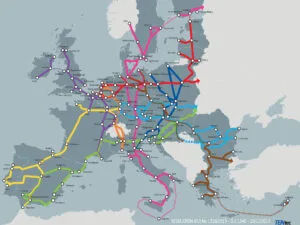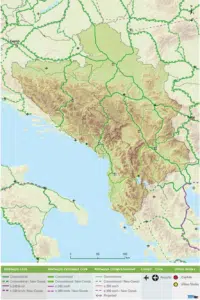Brussels – The future of the European Union will be even more interconnected, especially on rail. With the agreement between negotiators from the EU Parliament and Council on the updated guidelines for the Trans-European Transport Network Ten-T, the continent is opening up to a short-, medium- and long-term future in which all large-scale cross-border network projects of railways, roads, inland waterways, and short sea routes connected through ports and terminals across the Union will be a reality. “With the new rules, we are creating the conditions for a shift to greener modes of transport, while stimulating the mobility of Europeans and the competitiveness of our economy,” is the assurance of the rapporteur for the EU Parliament, Dominique Riquet (Renew Europe), commenting on the outcome of the negotiations concluded late last night (Dec. 18).

Ten-T is the European cross-border network connecting 424 major European cities that, when completed, will reduce travel time on any means of transportation. The proposed revision of the 2013 Regulations was presented by the EU Commission in December 2021 with new time targets for completion of the network, but was revised in July last year in light of the political and economic consequences of the Russian invasion of Ukraine. The guidelines agreed upon by the co-legislators—which will have to be finalized at the technical level and then approved individually by each institution before being published in the Official Journal of the EU—represent the plan for the construction of railways, roads, inland waterways, and short sea routes, among which appear the Brenner Base Tunnel between Italy and Austria, the Helsinki-Warsaw Rail Baltica, and the Lisbon-Madrid high-speed rail line.
The tentative agreement maintained the three-stage approach envisioned in the commission’s proposal: until 2030 for the core network, 2040 for the extended core network, and 2050 for the global network. In particular, the new intermediate deadline of 2040, introduced to bring forward the completion of large-scale projects from the initial target of 2050, should be taken into account. In parallel, to ensure that infrastructure planning meets “real operational needs” (i.e., an integration of railways, roads, and waterways), the new Regulation also creates nine European transport corridors, which according to the co-legislators “are of the utmost strategic importance” for the development of sustainable and multimodal transport flows in Europe, both for freight and passengers. In this regard, by 2030, electrified railways in the core Ten-T network will travel at speeds of 160 kilometers per hour for passenger transport and 100 kilometers per hour for freight and will cross internal EU borders in less than 25 minutes on average, while by 2040 there will have to be a shift to a single traffic management system.

The Ten-T railway network in the Western Balkans
Precisely in response to the impact of the Russian war in Ukraine, the revised Regulations extend four Ten-T corridors to Ukraine and Moldova, while cross-border connections with Russia and Belarus are cut. Also to ensure better connectivity with key neighboring countries, the network strengthening with Western Balkan partners will also continue. On a general level, airports in major European cities with a total annual traffic of more than 12 million passengers will have to be connected to the trans-European rail network, while by 2027 all 424 major cities along the Ten-T network will have to establish a sustainable urban mobility plan (zero-emission and with improved walking and cycling infrastructure). The design and upgrading of road transport for civilian use—with measures such as separate roadways for the two directions of travel, or separation by a dividing strip not intended for traffic—will also need to consider military requirements (weight and size) when overlapping, to ensure seamless transfer of troops and equipment.
English version by the Translation Service of Withub



